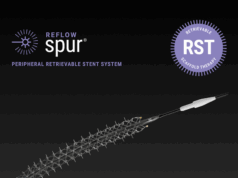
Results from the PROMISE II pivotal trial investigating transcatheter arterialisation of the deep veins using the LimFlow system in so-called no-option chronic limb-threatening ischemia (CLTI) patients were today published in the New England Journal of Medicine (NEJM).
The publication confirmed an amputation-free survival rate of 66% at six months, which exceeded the trial’s primary endpoint target of 54%, as reported by co-principal investigator Daniel Clair (Vanderbilt University, Nashville, USA) at the 2022 Vascular Interventional Advances (VIVA) meeting (31 October–3 November, Las Vegas, USA).
PROMISE II—multicentre, prospective and single-arm—included 105 patients with CLTI. The pool bore a median age of 70, 33 (31.4%) were women and 45 (42.8%) were Black, Hispanic, or Latino.
Transcatheter arterialisation of the deep veins was performed successfully in 104 patients (99.0%), the researchers report in NEJM. At six months, 66.1% of the patients had amputation-free survival. “Limb salvage (avoidance of above-ankle amputation) was attained in 67 patients (76.0% by Kaplan–Meier analysis),” they write. “Wounds were completely healed in 16 of 63 patients (25%) and were in the process of healing in 32 of 63 patients (51%). No unanticipated device-related adverse events were reported.”
Patients enrolled in PROMISE II “were representative of real-world patients,” including those with dialysis-dependent chronic kidney disease (CKD) and Rutherford class 5 or 6 wounds—groups “routinely excluded” from vascular device studies, the triallists noted in the discussion section of their paper.
Prespecified subgroup analyses indicated a difference between the 19 patients with dialysis-dependent CKD—who had amputation-free survival of 36.8%—and the 86 patients who did not (72.7%), the authors report. Similarly, the mortality rates among these groups of patients were 36.2% (dialysis dependent) and 8.6%, they show.
“Results of a prespecified subgroup analysis were aligned with those of previously published outcomes indicating an increased risk of death after peripheral arterial revascularisation procedures among patients who were undergoing dialysis,” they write. “Although the incidence of limb salvage was similar between patients who had dialysis-dependent chronic kidney disease and those who did not, mortality appeared to be greater in the population with dialysis-dependent disease. The decision to offer transcatheter arterialisation of the deep veins to patients with dialysis-dependent chronic kidney disease should take into consideration life expectancy and patient preferences.”
The LimFlow transcatheter arterialisation system is designed to re-establish blood flow in deep veins for end-stage CLTI patients who have exhausted all other treatment methods and face major amputation of their lower limb. Trial subjects will be followed out to three years.
“The publication of PROMISE II in the New England Journal of Medicine reinforces the transformational value of [transcatheter arterialisation of deep veins] for a patient population in great need,” stated Mehdi Shishehbor (Harrington Heart and Vascular Institute, University Hospitals, Cleveland, USA) PROMISE II’s other co-principal investigator, who is president of the and lead author of the NEJM paper. “The introduction of this therapy provides the possibility of limb salvage for a no-option CLTI population previously consigned to primary amputation, potentially reducing the suffering, mortality, and economic burden in this ever-growing segment of patients.”
“These results establish [transcatheter arterialisation of deep veins] as a real alternative to major amputation for patients facing inevitable limb loss from no-option CLTI,” added Clair. “This therapy will enable us to redefine the concept of a ‘no-option’ CLTI patient by giving us a treatment that offers patients limb salvage and hope.”
The LimFlow system—an investigational device in the USA—attained a CE mark for use in the European Union in 2016.










